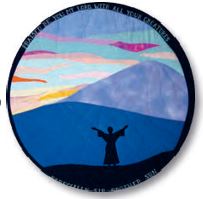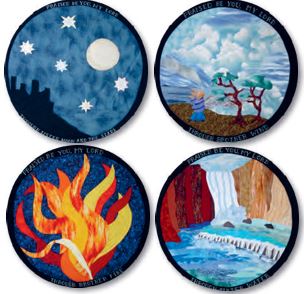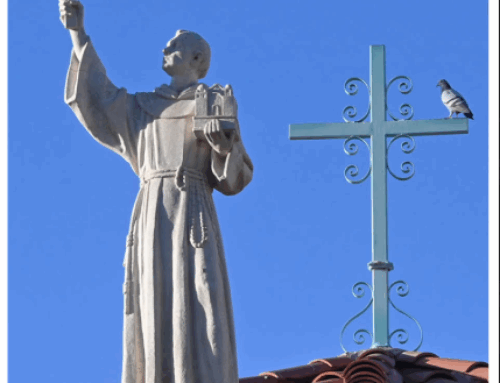Justin Carisio, OFS National Formation Commission
 St. Francis of Assisi was inclined to express himself in words, and we are fortunate that a number of his prayers, letters, and other writings have been preserved and passed down to us. They give us insight into his vision of the gospel life, and they help us understand what he thought and believed.[1]
St. Francis of Assisi was inclined to express himself in words, and we are fortunate that a number of his prayers, letters, and other writings have been preserved and passed down to us. They give us insight into his vision of the gospel life, and they help us understand what he thought and believed.[1]
Among Francis’s writings is his magnificent outpouring of praise, “The Canticle of the Creatures.” Perhaps nothing that Francis wrote resounds in our world today as much as this great poem.[2] It echoes through the centuries as both a religious and literary text. We encounter it in many ways. As a written work certainly, but also adapted for hymns and songs and interpreted creatively in the visual arts. It underlies our association of Francis with nature, affirming for us his love of the created world and his understanding of how all of creation, by its very existence, praises the Creator. The Canticle also supports his designation as patron of ecology. More recently, Pope Francis’s encyclical subtitled “On Care for Our Common Home” takes its title from the anaphora of the Canticle, “Laudato si’, mi’ Signore” – “Praised be you, my Lord.”
It is further testament to the authenticity and originality of St. Francis that even though we encounter the Canticle often and in different ways, his song retains its power to inspire us. Even so, we should not take the Canticle for granted. Using our imaginations, we can bring fresh insights to the poem. We can find ways to keep his voice resonating anew for us. Consider a few thoughts along these lines:
- The Canticle captures Francis’s spirit and presents his worldview in a way unmistakably his own. G.K. Chesterton famously said that the Canticle “is a supremely characteristic work, and much of St. Francis could be reconstructed from that work alone.”[3] In other words, if you would know the heart and mind of Francis, begin with the Canticle.
- Francis was a medieval man. His understanding of the cosmos and God’s creation was very different from our We are amazed by striking photos from the Webb telescope of innumerable galaxies billions of light years away. But in the world of the 13th century, there was no such comprehension of space and time. Francis would have believed the earth to be the center of the universe. He did not know the sun’s immensity or how it generated heat and light. He would not have known the physical nature of the moon, or that the stars were other suns. Because of this, Francis’s view of creation may have been more mystical and intimate than ours, which has been formed in part by the science of our time. As we enter the spirit of the Canticle, we can rejoice in our modern awareness even as we try to see the world through his medieval eyes.
- The creatures named in the first section of the Canticle (verses 1-9) are inanimate. Francis does not include any animals; he mentions plants (flowers and herbs) only in passing. We can speculate as to why he chose the creatures he did. There was nothing in his experience of creation grander than Sir Brother Sun or more strikingly beautiful than Sister Moon and the stars. None more useful than Sister Water or more essential to life than Sister Mother Earth. Few were more mysterious than Brother Wind and Brother Fire.
- Each of the creatures he names exists in obedience to God. In “The Admonitions,” he reminds the friars (and us) that “all creatures under heaven serve, know, and obey their Creator, each according to its own nature, better than you.”[4]
- Although Francis is very focused on the literal attributes and physical reality of the creatures he names, keep in mind that as with any great poem, there are other meanings implied or symbolic. Regis Armstrong, OFM Cap, offers one such insight, “Brother Wind, Sister Water, and Brother Fire can obviously be seen as references to the Spirit… Each one presents a reflection in itself of the triune presence, thus pointing beyond itself to the power, wisdom, and goodness of God.”[5]
- If there is a single adjective that describes Francis’s view of creation more than any other, it may well be “beautiful.” Francis uses that word three times in the Canticle.
- Francis does not appear to be concerned with the idea of creation as much as with his experience of and relationship to other creatures. In this the poem prepares us for the awe that Francis reserved for the Incarnation – the Son of God assuming human nature in Jesus Christ, true God and true man.[6]
- Francis introduces people into verses 10 and 11, which he added during a time of unrest in Assisi.[7] These verses speak to us in our own We should take to heart his hope that God will be praised by those “who give pardon for Your love,” “bear infirmity and tribulation,” and “endure in peace.”
- Verses 12 and 13 were composed as Francis lay dying.[8] To see death as sister, “an instrument of God’s presence,”[9] was one of Francis’s profound insights, and verse 12 is well worth contemplating again and again.
- Francis wrote the Canticle in the vernacular – his native Umbrian – and it is considered one of the earliest works of literature in Murray Bodo, OFM, tells us the Canticle “can only be fully appreciated in its original form, because the nuances, rhythms, and sounds of a great poem are the most exquisite articulation of its native language.”[10] The Internet offers examples of the Canticle recited in the original form. Search for one and listen. Even those of us unfamiliar with Italian can benefit from its beauty spoken or sung as originally composed.
We do well to return to the Canticle repeatedly to share Francis’s joy, to join in his wonder, and to rediscover with him our universal kinship with creation. Let us continue to celebrate his beautiful “poetic praise of God.”[11]

These images are of a series of quilt hangings, by Cindy Wesley OFS, depicting The Canticle of the Creatures, located at the San Damiano Retreat Center, CA.
[1] Thaddée Matura, OFM. Francis of Assisi Writer and Spiritual Master, (Cincinnati: Franciscan Media, 2005), 8
[2] The English text can be found in Francis of Assisi: Early Documents (FA:ED), edited by Regis J. Armstrong, OFM Cap., Wayne Hellmann, and William J. Short (New York, London, and Manila: New City Press, 1999), Vol 1, 113
[3] Chesterton, G. K., Saint Francis of Assisi, (New York: Image Books, 1957) 90
[4] See Admonition V, FA:ED, Vol 1., 131. Also, Robert J. Karris, OFM, The Admonitions of St. Francis: Sources and Meanings, (St. Bonaventure, New York: The Franciscan Institute, S. Bonaventure University, 1999), 81
[5] Regis J. Armstrong, St. Francis of Assisi, Writings for a Gospel Life, (New York: Crossroad Publishing Company, 1994) 211
[6] Catechism of the Catholic Church, 2nd ed. (Vatican: Libreria Editrice Vaticana, 2019) 116-117
[7] FA:ED, Vol 1, 113-114
[8] FA:ED, Vol 1, 113
[9] Armstrong, 238 Which one?
[10] Murray Bodo, OFM, Poetry as Prayer: St. Francis of Assisi, (Boston: Pauline Books and Media, 2003) 58.
[11] FA:ED, Vol 1, 113. See also http://franciscanseculars.com/a-visual-meditation-st-francis-in-art/.



Leave A Comment